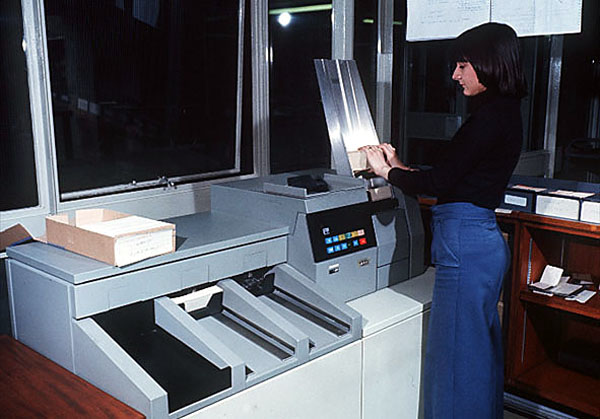
| Mus.Cat. NEWUC:2004.16 | Mnfctr: IBM | Date: 1966 | Ser. No: - | Model: - |
| Comp: Card Carrying Case | Width: 490 mm | Depth: 230 mm | Height: 100 mm | Weight: 6600 g |

This is a punch card carrying case.
In the 1960s the computer was remote from the computer user.
So the user prepared their information to program the computer on punch cards.
The cards then had to be taken to the computer, it might be just a walk or many miles away.
In the latter case the deck of cards had to be securely contained so as not to become
jumbled up or damaged. Hence the secure card carrying case.

Opening the case reveals the punch cards.
There were probably several decks of cards:
programs; sub-routines; sets of data; and at the end a padding of blank cards
to keep the whole in place.
The capacity was 2000 cards, or in modern parlance 20KBytes. It weighed 6.6Kg.

This is an 80 column punch card. It is 187.325mm wide by 82.55mm deep,
or more interestingly 73/8" wide by 31/4" deep.
This is the size of American treasury notes whose containers Herman Hollerith used
to hold his punch cards used to analyse the American Census of 1890.
His punch cards used round holes and only encoded 45 characters.
In 1924 IBM who had taken over the tabulating company that owned the patent
on punch cards realised that you do not need a round hole to detect it with metal brushes,
just a long one, so invented the 80 column punch card.

This is a punched card with the letters of the alphabet in the first 26 columns,
followed by the ten digits 0-9 (Just a single punch per column),
then the special characters (mostly three holes per column).
This was to be the method of data entry, along with paper tape,
until the introduction of the Teletype terminal that was directly connected to a computer.

Here is a data preparation room, there is a row of card punches,
not connected to a computer, but just for making punch cards.
At the left is an 029 Card Punch.
It consisted of a keyboard, and above it at the top-right a blank-card input hopper.
The cards were fed down to the punch station just above the keyboard.
As the user pressed a key so the character was punched in the card
and then it moved a column to the left.
Eventualy the user pressed RETURN and the card was moved to the bottom of the output hopper
at the top left and a blank card fed down to the punch station ready for the next line of input.

This is a 2540 Card Reader/Punch.
It weighs 216Kg and used 1.3KVA of electricity.
It reads cards at 1000 cards per minute. Punches them at 600 cards per minute.
The computer operator is placing cards in the input hopper.
After reading they were stacked in one of the output hoppers in the middle of the machine.
At the opposite end is the card punch hopper where blank cards were placed.

This is a different card reader.
The computer operator is loading cards into the input hopper.
They will be read and stacked in an output hopper on the left.
| Mus.Cat. NEWUC:2004.10 | Mnfctr: unknown | Date: 1940 (circa) | Ser. No: - | Model: - |
| Comp: Manual Card Punch | Width: 450 mm | Depth: 159 mm | Height: 158 mm | Weight: 4035 g |

This is a hand card punch.
To use it you actually needed to know
what the hole punches were required in a column for every character.